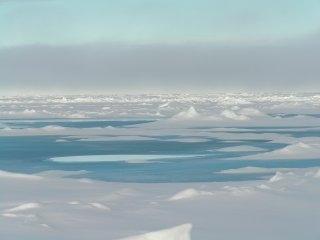
|
|
24 August, 2004
Drilling is halted due to the ice situation.
We have temporarily suspended the drilling and the Vidar Viking has pulled
up the drill string. The Oden and the larger Russian icebreaker, Sovetskiy
Soyuz (Soviet Union), continuously steam in circles up drift to keep the ice
floes broken up and of a “manageable” size. When the ice becomes
“unmanageable”, that means that the icebreakers are not able to adequately
break it up to protect the drill ship and equipment from being hit by big
pieces of ice, so drill operations are halted.
The ice situation can change drastically from hour to hour here in the
Arctic. It is quite a job to keep track of the ice floes, their size,
thickness and movement. All of this ice forecasting is critical because the
core drilling on the Vidar Viking is dependent on that ship maintaining a
safe and steady location within 50m of the drill site, and unmanageable ice
pushing against the ship could jeopardize its ability to do that. The Ice
Management Team on the bridge, working with the Meteorologists, is
responsible for monitoring and reporting on the ice.
Members of the Ice Team, like other positions, must be on duty around the
clock. They keep track of the ice thickness, speed and direction, the
development (age) of the ice – “first year”, “second year”, or “multiyear”,
as well as the total concentration of ice in the area. While the central
area of the Arctic Ocean is ice-covered year round, ice in the southern
regions melts and freezes seasonally. “First year” ice is new ice that
starts to form in early September where we currently are, and in November in
the more southerly regions; this is when the ice season starts. New ice
crystals form a thin sheen on the water that is called “grease” ice. It
then freezes into rounded forms of new ice called “pancake ice” because it
looks like pancakes; this ice can be 30cm-3m diameter and 5 to 10 cm thick.
First year ice can develop to be about 2 meters thick by April. If it
survives the summer to the 1st of September, then it is called “second year”
ice and then if it survives another summer it becomes “multi-year” ice. The
multi-year ice is what has been causing most of the problems on this
expedition because it is so thick and hard and difficult to breakup. Also,
ice floes can be pushed together by wind, causing the ice where the floes
meet to break up and to rise up into “pressure ridges” which can be 20 or
more meters thick. If these pressure ridges survive the summer, they freeze
solid the following winter and become very strong. When multiyear ice is in
floes of 1000 m or more in diameter and over 4m thick, it is a serious
problem for the operation.
The situation is compounded right now because the fog is too thick for the
helicopters to fly ice reconnaissance. We have to move to another area where
the ice is thinner, but we cannot do this without the helicopter
reconnaissance. So for now we wait. Scientists are catching up on sampling
the sediments but are also anxious for the cores to start coming up again.
It was great to have some preliminary results from 270 meters of sediment
and to hear the discussions begin as to what the sediments can tell us. The
story was so exciting, but now we wait a bit for the next chapter.

Ice at Midnight.
Contact the TEA in the field at
.
If you cannot connect through your browser, copy the
TEA's e-mail address in the "To:" line of
your favorite e-mail package.
|
